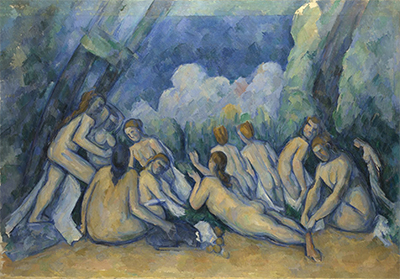The Bathers, an oil painting first exhibited in 1906, was executed by Paul Cezanne. The painting displayed in the Philadelphia-based Philadelphia Museum of Art is the largest of the Cezanne's series of Bather paintings.
The other paintings are in the Art Institute of Chicago, Philadelphia, the Barnes Foundation, London, National Gallery, and the New York City-based Museum of Modern Art.
Details of the painting
Sometimes referred to as the Large Bathers or Big Bathers to distinguish the painting from the other smaller works, the Large Bathers is regarded as Cezanne's finest work and a masterpiece of modern art. It was featured in the BBC2 series called 100 Great Paintings.
The atmosphere of the Large Bathers is beautiful and strange: The landscape is bluish, a soft mist in which water, vegetation and sky merge and by which the skilfully drawn figures are carefully overcast. The artist worked on this painting for 7 years; it remained unfinished when he died in 1906. In 1937, Joseph E. Widener, who was the major benefactor, bought the painting for 110,000 dollars with funds from the Philadelphia Museum of Art trust fund. Leo Stein was the previous owner.
Techniques used
The abstract nude females seen in Large Bathers give this painting density and tension. It's exceptional among Cezanne's work in terms of symmetrical dimensions. The artist adapted the use of nude forms and the triangular patterns of both the river and trees. Using the same techniques used in painting still lifes and landscapes, Large Bathers painting is reminiscent of Sir Peter Paul Rubens and Titan's work. People also often make comparisons with Les Demoiselles d'Avignon by Pablo Ruiz Picasso, which was executed in the same period and is also a famous series of nude women.
With each version of this painting, the artist moved away from the usual presentation of paintings and intentionally created works that wouldn't appeal to novice viewers. Cezanne did that to avoid fleeting trends and give quality to his work that will remain timeless. In turn, this paved the way for the artists that came after him to disregard current fads and execute pieces that are appealing to all generations.
Influence
Cezanne formed the bridge between the late nineteenth-century Impressionism movement and the early twentieth century's line of artistic enquiry, avant-garde art movement called Cubism. His work - with its sense of incompletion and immediacy - critically influenced the French artist Henri Matisse and others before Fauvism and Expressionism. In 1922, Henry Spencer Moore was impressed with The Large Bathers by Cezanne and stated that the time he saw the masterpiece was one of the memorable moments in his life.




